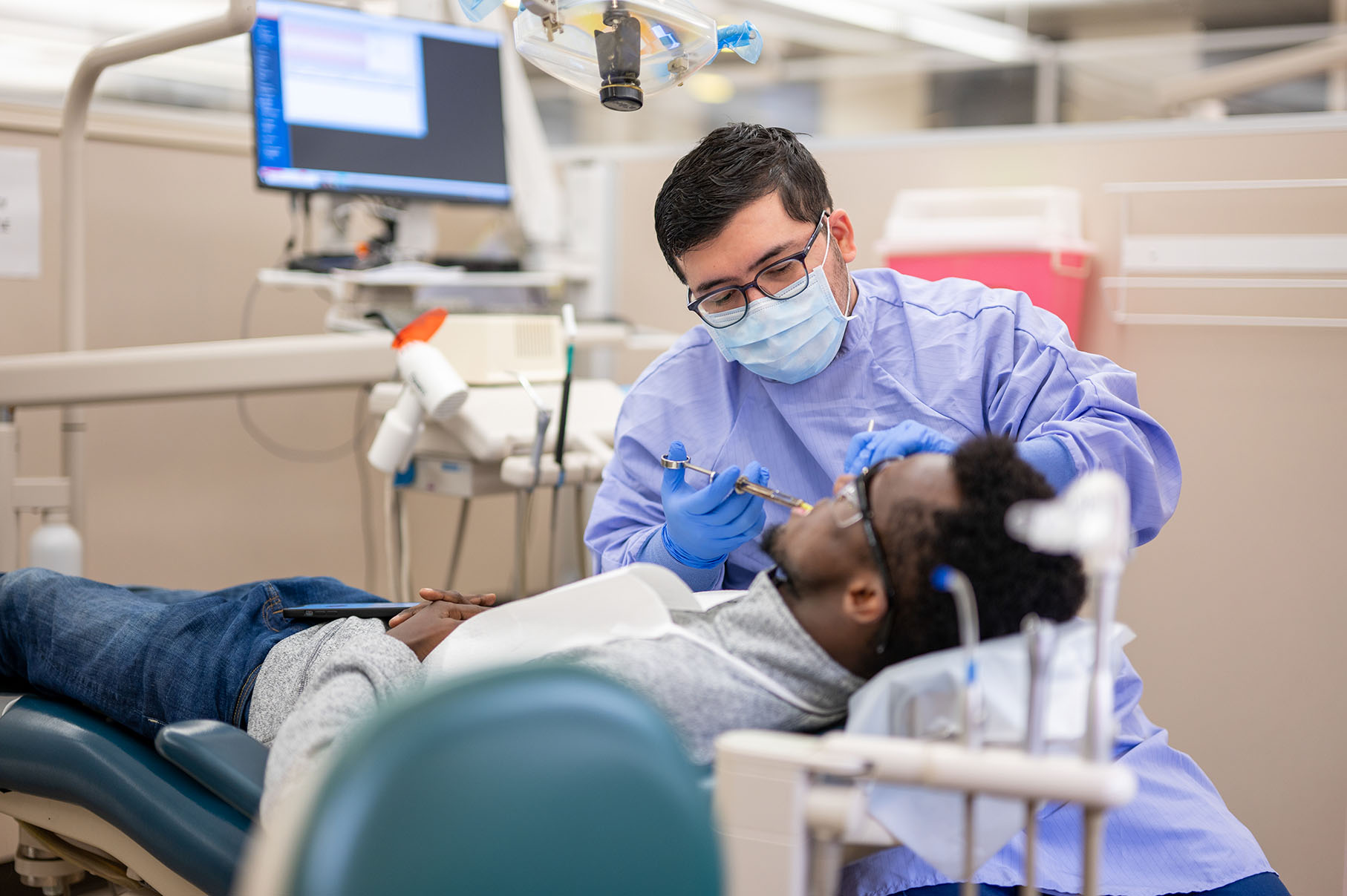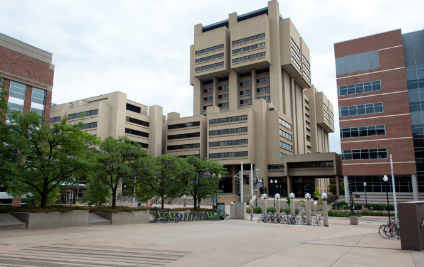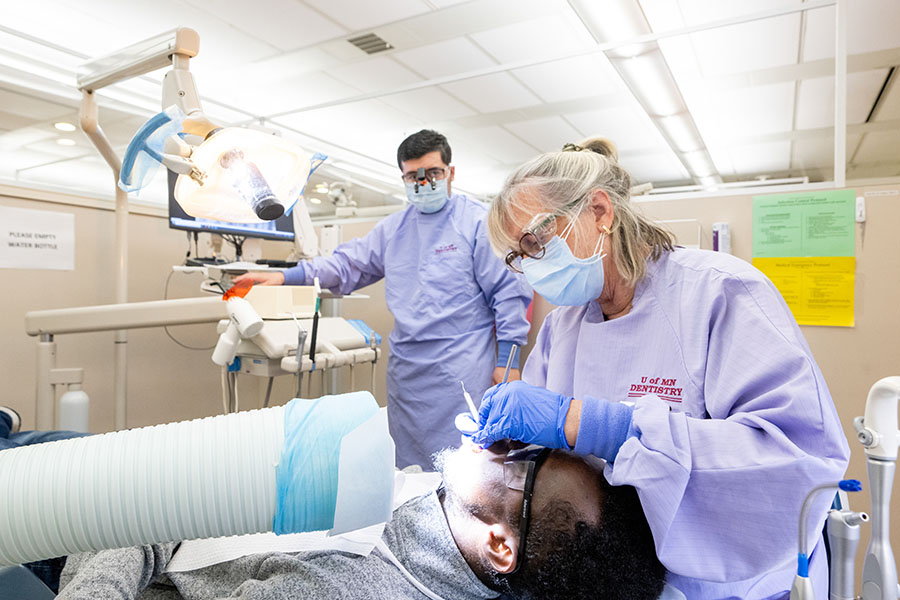

About Periodontology
Periodontology is the specialty of dentistry encompassing the prevention, diagnosis and treatment of diseases of the supporting and surrounding tissues of the teeth, including gum disease.
Do you require urgent dental care?
Patient Information
Procedures Performed
Periodontal Disease (Gum Disease) Treatment
Periodontal disease, also called Periodontitis, is an inflammatory disease that affects the gums and bone around our teeth. Periodontitis causes gums to bleed and also leads to a loss of supporting bone around teeth. In our clinic, we specialize in a variety of non-surgical and surgical services to treat periodontal problems.
Each patient begins with an initial consultation with one of our residents, where we get to know the patient, gather clinical information, and develop a comprehensive treatment plan. Our goal is to educate each patient on their periodontal condition as well as what potential treatment options are available. Every patient and situation is unique, and we welcome discussions with our patients and encourage them to choose the best treatment method that meets their needs. Here are some of the periodontal treatment options we offer in our clinic:
Scaling and Root Planning (deep cleaning)
Scaling and Root Planning is a non-surgical procedure to remove plaque and calculus from deep under the surface of the gums. The patient is usually numbed for the procedure, so they are comfortable. This procedure is typically followed up by a re-evaluation in 1-2 months.
Periodontal Maintenance
Periodontal maintenance is similar to a normal dental cleaning, but is designed to be more robust to remove plaque and calculus from above and below the gums in patients with gum disease. If needed, the clinician will numb the patient to address any areas of significant gum inflammation. Periodontal maintenance typically follows after deep cleanings or surgical procedures, and allows the clinician to monitor patients with periodontal disease to maintain oral health and intervene if disease returns.
Osseous Surgery
For patients with more severe periodontal disease, our clinic can perform a procedure that recontours the gums and bone to remove disease and gives the patient healthier gums that they can maintain. The procedure involves local anesthesia for patient comfort.
Guided Tissue Regeneration
Periodontal disease results in bone loss around teeth. In some cases, that lost bone can be rebuilt to improve the health and stability for the teeth. While this is not possible in every case, your resident will explain if you are a candidate for this procedure.
Functional and Cosmetic Crown Lengthening
Crown lengthening is a simple surgical procedure where the position of the gum around a tooth is adjusted to expose more of the tooth structure. This procedure is completed to make the teeth appear longer for cosmetic reasons, or to provide more space for a crown on top of a tooth. Local anesthesia is used to provide patient comfort.
Bite Adjustment
When the upper and lower teeth are not contacting each other properly, the supporting structures around the tooth can become inflamed and lead to tooth mobility along with patient discomfort. Our clinic can perform a procedure that makes minor adjustments to the teeth surfaces so they contact more evenly and reduce the trauma on supporting structures.
Laser
Patients with periodontal disease can also be treated with a laser that is designed to eliminate the bacteria and inflammation around teeth while also promoting healing. Depending on the severity of periodontal disease, a laser therapy treatment may be used instead of an Osseous Surgery. Your resident will explain if you are a candidate for this procedure.
Cosmetic Periodontal Procedures / Gum Grafting
Soft Tissue Grafting
Gum recession is where the gum tissue around your teeth moves lower and exposes more of your tooth surface. Often times, patients will see this as their teeth appearing longer. When gum recession occurs, patients may not like the way their teeth look, or may also notice increased tooth sensitivity due to more exposed tooth surface. Our clinic provides soft tissue grafting procedures that can restore gum tissue over teeth, and also thicken gum tissue to prevent future recession. Your resident will perform an examination and explain the options in addition to the expected results for a soft tissue graft procedure.
Soft Tissue Grafting is usually accomplished by using the patient’s own tissue, typically from the roof of the mouth, and transplanting that tissue to areas of recession or thin gum tissue. Local anesthesia is used throughout the procedure to ensure patient comfort.
Soft Tissue Grafting – alternatives to self graft
While using the patient’s own tissue for soft tissue grafting has been shown to provide superior results, the idea of taking tissue from the roof of the mouth is not desirable or possible for some patients. Therefore, our clinic offers other tissue grafting options, such as Alloderm, which is a human donor tissue matrix that can be used instead of the patient’s own tissue. The advantage of this option is that there is no need to use tissue from the roof of the mouth. Your resident will discuss if this is a good option for you.
Bone Grafting
Socket Preservation
When a tooth is removed, the bone around that tooth starts to shrink – sometimes up to 60%! If you desire to replace your tooth with a dental implant in the future, we want to prevent that bone shrinkage so there is adequate bone to place an implant. Socket Preservation is a procedure offered in our clinic that removes a failing tooth and simultaneously places bone graft material in the tooth socket to minimize the bone shrinkage during healing.
Ridge Augmentation
Sometimes there is not enough bone to place dental implants. In order to restore the lost bone dimension, a procedure called Ridge Augmentation can be performed that uses bone grafting material to rebuild lost bone. Recent advances in technology have dramatically increased the success of bone grafting procedures, leading to bone formation that can facilitate implant placement. Your resident will discuss the different options for ridge augmentation, the timeline for healing, and the expected results.
Sinus Lift
In the top dental arch (maxilla), there is sometimes not enough bone to place dental implants in the back due to a shrinkage of bone below the sinus cavities. To rebuild lost bone in the back of the maxilla, a sinus augmentation procedure, often called a sinus lift, can be performed to increase the vertical height of bone at the maxillary sinus floor to allow for placement of dental implants in patients. There are several techniques for sinus augmentation, and your resident will explain the best option for your situation.
Tooth Replacements
Dental Implants
Dental implants are designed to provide a foundation for replacement teeth which look, feel and function like natural teeth. Dental implants have a very high success rate and can provide an excellent esthetic and functional solution for patients missing teeth. Our residents use the industry’s most advanced implant planning software to ensure the right implant is placed in the best location. The dental implant placement procedure is completed using local anesthetic to ensure patient comfort.
Dental Implant Diseases (Peri-Implantitis)
While dental implants have very high success rates, they can still become infected (called peri-implantitis), just like normal teeth. When this happens, bone around implants can be lost, sometimes rapidly. Our clinic offers procedures to remove the disease and potentially replace lost bone around the dental implant. Your resident will provide the treatment options and expected outcomes so you can make the best decision for your implant.
Sedation Services
It is natural for dental procedures, especially dental surgeries, to make patients nervous. To help make patients more comfortable, our clinic offers a range of sedation services to help patients relax during procedures. Sedation is endorsed by the American Dental Association and is an effective way to make many patients comfortable during their dental visit. The sedation options in our clinic include nitrous oxide gas (sometimes called “laughing gas”), oral sedation (usually a pill that reduces anxiety), and moderate sedation through an IV. While these sedation techniques do not make the patient “go to sleep”, they can significantly improve the experience during more involved procedures. Your resident will discuss options for sedation and can help select the appropriate sedation method for you.
Orthodontic-related Service
When teeth develop, sometimes they do not come into the mouth in the right location. When this happens, our clinic partners with an orthodontist help bring the tooth into the right position. This usually involves a surgery where the tooth is exposed and connected to a device that helps guide the tooth into the right position.
Periodontally Accelerated Osteogenic Orthodontics (PAOO)
Orthodontic treatment can take a long time, and sometimes patients would like to speed up the treatment time. PAOO is one way to accelerate the movement of teeth and reduce the time of orthodontic treatment. PAOO is a surgical treatment performed in combination with the orthodontic treatment that caused the bone around teeth to remodel faster, therefore allowing teeth to move into position sooner. The PAOO procedure can also help maintain healthy bone levels around teeth during tooth movement.
Digital Technology
CBCT (3D x-rays)
Our clinic is equipped with a state-of-the-art CBCT that takes a 3D x-ray of your mouth. This 3D x-ray gives your clinical team highly detailed information on your bone and teeth, which helps in the planning phase for many procedures, like implant placement, bone grafting, PAOO, and others.
Intra-Oral Scanner
Our clinic uses an intra-oral scanner to build a digital model of your upper and lower teeth. While you might remember taking an impression with a mouth tray filled with soft material that hardened over time, our clinic uses a highspeed scanner that creates a digital model of your teeth in a few minutes. No more uncomfortable impressions.
Digital Planning and 3D Printing
Our clinic uses cutting edge technology to digitally plan surgical procedures. Using information from a CBCT and intra-oral scanner, our residents can accurately plan the position of a dental implant to ensure it will perform at the highest level. Residents also use a 3D printer to create a surgical guide that helps place the implant in the exact right location during surgery.
Contact

University of Minnesota Advanced Periodontics Clinic
515 Delaware St. SE
7th Floor - Moos Tower
Minneapolis, MN 55455
Phone: 612-625-6177

